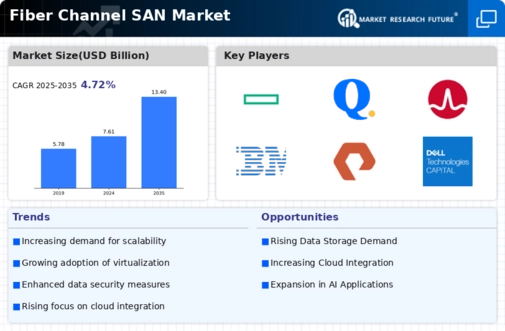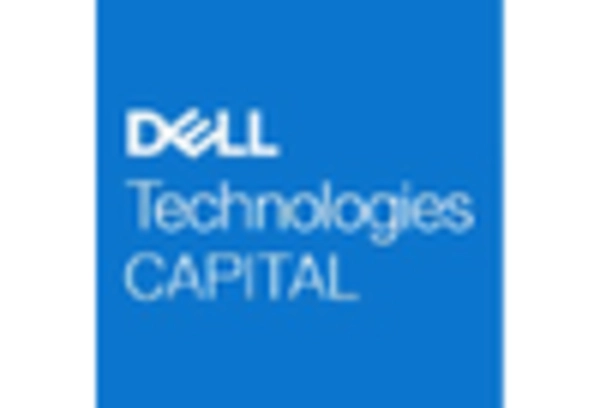Rising Data Storage Needs
The Fiber Channel SAN Market is experiencing a surge in demand due to the increasing volume of data generated by enterprises. Organizations are seeking efficient storage solutions to manage this data effectively. According to recent estimates, data generation is expected to reach 175 zettabytes by 2025, necessitating robust storage infrastructures. Fiber Channel SANs provide high-speed data transfer and reliability, making them an attractive option for businesses aiming to optimize their storage capabilities. This trend is likely to drive investments in Fiber Channel SAN technologies, as companies prioritize scalable and efficient storage solutions to accommodate their growing data requirements.
Shift Towards Hybrid IT Environments
The shift towards hybrid IT environments is influencing the Fiber Channel SAN Market significantly. Organizations are increasingly adopting a mix of on-premises and cloud-based solutions to leverage the benefits of both models. Fiber Channel SANs play a crucial role in this transition, offering the necessary connectivity and performance to integrate on-premises storage with cloud services. As businesses seek to create flexible and scalable IT infrastructures, the demand for Fiber Channel SANs is expected to rise. This trend may lead to innovations in storage technologies, as vendors strive to enhance compatibility and performance in hybrid environments.
Growing Need for Enhanced Performance
The Fiber Channel SAN Market is driven by the growing need for enhanced performance in data storage solutions. As applications become more data-intensive, organizations require storage systems that can deliver high throughput and low latency. Fiber Channel SANs are engineered to meet these demands, providing superior performance compared to traditional storage solutions. Recent data indicates that organizations utilizing Fiber Channel SANs can achieve up to 10 times faster data transfer rates. This performance advantage is likely to attract more enterprises to adopt Fiber Channel SAN technologies, as they seek to optimize their IT infrastructure for better efficiency.
Integration with Virtualization Technologies
The integration of Fiber Channel SAN Market with virtualization technologies is becoming increasingly prevalent. As organizations adopt virtualization to enhance operational efficiency, the need for high-performance storage solutions becomes critical. Fiber Channel SANs offer the necessary bandwidth and low latency required for virtualized environments, enabling seamless data access and management. The virtualization market is projected to grow significantly, with estimates suggesting a compound annual growth rate of over 10 percent in the coming years. This growth is likely to bolster the Fiber Channel SAN Market, as businesses seek to leverage virtualization alongside robust storage solutions.
Demand for High Availability and Disaster Recovery Solutions
In the Fiber Channel SAN Market, the demand for high availability and disaster recovery solutions is intensifying. Organizations are increasingly recognizing the importance of data protection and business continuity. Fiber Channel SANs are designed to provide redundancy and failover capabilities, ensuring that critical data remains accessible even in the event of hardware failures. The market for disaster recovery solutions is projected to grow, with estimates indicating a potential increase of 15 percent annually. This trend underscores the necessity for reliable storage solutions, positioning Fiber Channel SANs as a preferred choice for enterprises focused on safeguarding their data.
















Leave a Comment